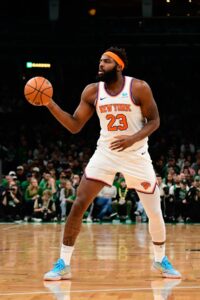Most salary cap workarounds, such as the mid-level exception, can be used every year — or at least every other year, as in the case of the bi-annual exception. However the disabled player exception is only available under certain circumstances. Like other salary cap exceptions though, the DPE allows a team to sign a player without using cap space.
If a player is seriously injured, his team can apply for the disabled player exception to replace him. In order for the exception to be granted, an NBA-designated physician must determine that the player is “substantially more likely than not” to be sidelined through at least June 15 of that league year.
If granted, the disabled player exception allows a club to sign a replacement player for 50% of the injured player’s salary or for the amount of the non-taxpayer’s mid-level exception, whichever is lesser.
For instance, if a team is granted a disabled player exception this season for a player earning $10MM, the exception would be worth $5MM. But if the injured player is earning $30MM, the DPE would be worth the equivalent of the mid-level exception ($12,822,000 in 2024/25).
 A team must formally apply for a disabled player exception and it requires the approval of the NBA. If the league-designated physician determines the player will likely be fully recovered and available before June 15, the team’s request will be denied. That happened last season when the Knicks attempted to secure a disabled player exception for Mitchell Robinson‘s ankle injury. That turned out to be the right call by the league, given that Robinson returned to action in late March.
A team must formally apply for a disabled player exception and it requires the approval of the NBA. If the league-designated physician determines the player will likely be fully recovered and available before June 15, the team’s request will be denied. That happened last season when the Knicks attempted to secure a disabled player exception for Mitchell Robinson‘s ankle injury. That turned out to be the right call by the league, given that Robinson returned to action in late March.
The cutoff to apply for a DPE each season is January 15. If a team has a player go down with a season-ending injury after that date, it cannot obtain a DPE to replace him. A team must also use the exception by March 10 of the current season or it will expire (this deadline can be pushed back to the next business day if March 10 lands on a weekend).
Unlike mid-level, bi-annual, or trade exceptions, the disabled player exception can only be used on a single player, rather than spread out across multiple players. However, a team can use it in a variety of ways — the DPE can be used to sign a free agent, to claim a player off waivers, or to acquire a player in a trade.
If a team uses its disabled player exception to take on salary in a trade, it can acquire a player making up to 100% of the DPE amount, plus $100K. For example, a $5,000,000 DPE could be used to trade for a player making $5,100,000.
A free agent signed using the DPE can only be offered a rest-of-season deal, while a player acquired via trade or waiver claim using the DPE must be in the final year of his contract. Essentially, the purpose of the exception is to give the team some flexibility to replace an injured player for the rest of the season, but not beyond the current season.
The team must have room on its roster to sign the replacement player — the disabled player exception doesn’t allow the club to carry an extra man beyond the usual limits.
In the event that a team is granted a disabled player exception, uses it to acquire a player, and then has its injured player return ahead of schedule (ie. before the end of the season), the team is allowed to carry both players.
However, if a team has an unused disabled player exception and then trades its injured player, the team would lose the exception. The same is true if the injured player returns to action before the DPE has expired or been used.
Most disabled player exceptions ultimately go unused. For instance, the Nuggets were granted a DPE due to DaRon Holmes‘ season-ending Achilles tear, but because he’s earning just $3,065,640 as a rookie, the exception is worth only $1,532,820, 50% of that amount. It doesn’t hurt for a team to have that tool as its disposal, but it will be difficult for Denver to do much with that.
More sizable disabled player exceptions can come in handy, most frequently in trades, where they can allow sometimes allow a team to generate a new trade exception with an outgoing contract rather than using it to match the incoming salary.
For example, after being granted a $12,405,000 DPE in the wake of Ja Morant‘s season-ending shoulder injury last season, the Grizzlies made a trade with Houston that sent out Steven Adams ($12.6MM) and brought back Victor Oladipo‘s expiring $9.45MM contract. Rather than using Adams’ outgoing salary as a salary-matching piece to acquire Oladipo, Memphis used its DPE to take on Oladipo’s deal, generating a new $12.6MM trade exception for Adams’ salary.
Notably, the Grizzlies had also been granted a separate $6.3MM disabled player exception for Adams after losing the big man to a season-ending knee injury, but they were forced to forfeit that DPE when they traded Adams away.
Note: This is a Hoops Rumors Glossary entry. Our glossary posts explain specific rules relating to trades, free agency, or other aspects of the NBA’s Collective Bargaining Agreement. Larry Coon’s Salary Cap FAQ was used in the creation of this post.
Earlier versions of this post were published in 2012, 2017, and 2022.